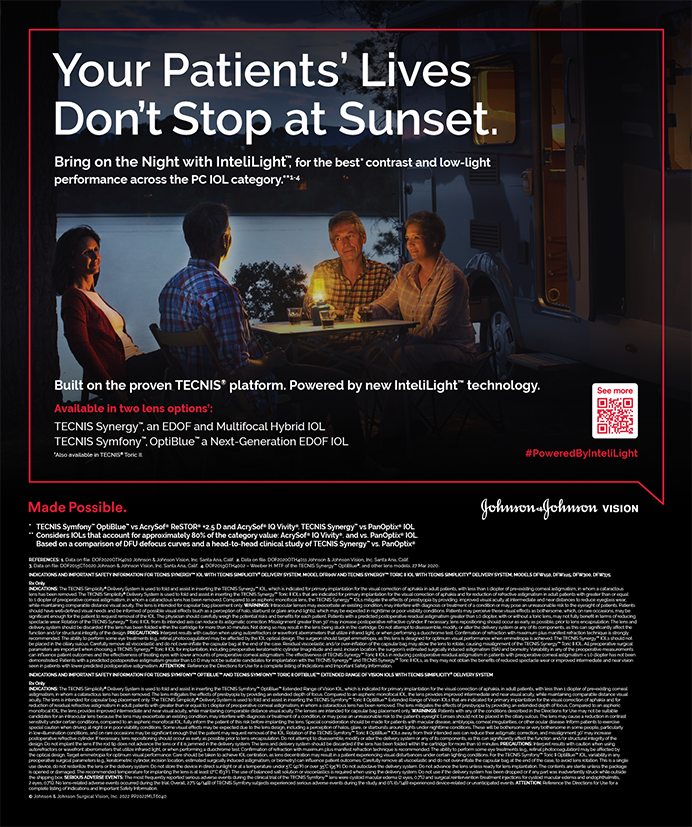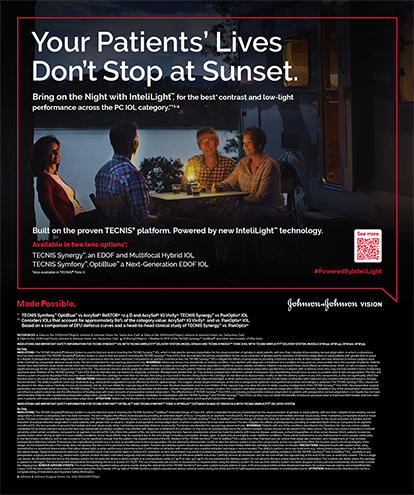For 47 years, I coped with wearing rigid gas permeable contact lenses. As an ophthalmic surgeon, I have implanted approximately 10,000 multifocal IOLs. Based on my experience, I decided to undergo the implantation of multifocal lenses to gain relief from having to wear glasses or contacts. For me, choosing a lens was easy because I understood that the presbyopia-correcting IOLs work well. I have implanted the Crystalens (Bausch & Lomb, Rochester, NY), the Array lens, and the ReZoom IOL (the latter two from Advanced Medical Optics, Inc., Santa Ana, CA). As for many of my patients, I felt that the ReZoom IOL was my best option.
CHOOSING A LENS AND A SURGEON
The gas permeable contact lens in my left eye had been out for 3 years, and the -1.12 D monovision I achieved afterward without glasses became insufficient when I was 64 years old. After observing Gayle Martin, MD, at Carolina Eye in Southern Pines, North Carolina, perform refractive IOL surgery and having shared surgical and practice ideas with him for more than 20 years, I picked him to perform my refractive lens exchange. I had my technicians attain my preoperative measurements, and I made my own calculations. The preoperative workup was repeated at Carolina Eye for comparison. Dr. Martin and I chose a lens, and he opted to add a limbal relaxing incision to treat 0.75 D of astigmatism.
THE PROCEDURE
That afternoon in March 2007, Dr. Martin performed surgery on my left eye through a smallish pupil without complications. During the procedure, I must have talked too much under the influence of Versed (Hoffmann-La Roche Inc., Nutley, NJ), so the anesthesiologist gave me more. As a result, I recall none of the procedure, and it took me 45 minutes in the recovery room before I could walk awkwardly out for my ride back to the motel. A 2-hour nap seemed appropriate at that point. Upon awaking, I felt much better, but my vision was smoky due to corneal edema or perhaps epithelial edema from the preoperative dilating drops.
I was amazed that I did not feel as if the Versed's side effects had completely worn off until 3 days after its administration.
POSTOPERATIVE RESULTS
At my first postoperative visit, I saw 20/20 at distance and 20/40 at 18 inches. If I glanced at reading material for 30 seconds, it slowly became sharper. During the first week after surgery, my vision improved to 20/15 at distance and 20/25 at near. I could read the newspaper at a distance of 10 to 30 inches, but it was somewhat difficult because of ghost images. From 2 weeks through 4 months postoperatively, I saw 20/15 2 at distance and 20/20 at near. My refractive error was 0.25 D; with a 0.50 D lens, the near 20/20 line was easy to read with minimal ghost images. At 4 months postoperatively, my reading vision improved so that print became clear after 2 seconds of concentration when viewed with my treated eye.
After the first postoperative week, I discontinued wearing the rigid gas permeable lens in my unoperated eye to allow the corneal molding to dissipate.
Six weeks after undergoing surgery on my first eye and 3 days after finishing my Pred Forte (Allergan, Inc., Irvine, CA), I awoke to see 20/30 blur at distance in my pseudophakic eye. I also noticed that the central 5° field of vision seemed to be through crinkled cellophane. Optical coherence tomography confirmed the presence of cystoid macular edema (CME). I started taking Pred Forte and Acular LS (Allergan, Inc.), both hourly. Within 3 hours, my vision returned to 20/15 2. I used the drops for a few weeks and have had no further CME.
Although I had not worn a contact lens in my second eye for 14 weeks, repeat keratometry continued to show steepening of 0.25 D. My cornea finally stabilized 4.5 months later, and I was ready to undergo surgery. This delay complicated matters somewhat, because my dominant unoperated eye had a refractive error of -1.75 D and constantly competed with the ReZoom IOL eye for near vision. As a result, my brain did not accept near images until 3 days after my second eye received the ReZoom IOL. After the second implant was placed, I could easily read newsprint.
I felt I needed to try to achieve a postoperative result of -0.37 D in my second eye to achieve the best uncorrected near vision. I aimed at -0.50 D. Five weeks postoperatively, I had a manifest refraction of -0.50 -0.25 X25 and uncorrected 20/15 vision at near, with excellent uncorrected intermediate distance vision. I developed CME in my second eye 14 days postoperatively. I increased my dosing of Pred Forte and Acular LS to every 2 hours, but no change in my vision or optical coherence tomography occurred. At week 4, a retrobulbar injection of Kenalog (Bristol-Myers Squibb Company, New York, NY) hastened my improvement back to 20/20 at near and distance. I still had enough CME adjacent to the fovea, however, to cause some blurring. At weeks 8 and 12, I received a sub-Tenon's injection of Kenalog, and the CME finally cleared. It appears that the retrobulbar injection caused me to develop some degree of ptosis and increased my IOP. Alphagan (Allergan, Inc.) is controlling the elevated pressure until it resolves.
With my left eye, I am able to see a crescent-shaped halo adjacent to streetlights. The halo is about the size of the streetlight and 40 of a circle. With my right eye, I see a similar halo on the right side of the light. I noticed these images, but they certainly are not a nuisance. They closely resemble what I saw with my contact lenses. During the past 6 months, my halos have not changed. Importantly, they are so insignificant that I only study them out of interest.
IN SUMMARY
In my experience, the happiest patients receive the ReZoom lens in their second eye within 1 to 3 weeks after their first surgery. I have never had an unhappy patient, even if years elapse between each eye's receiving the ReZoom lens, if the second eye is emmetropic and a significant cataract is not present. Also, in the past, I placed a multifocal lens in the second eye in about 60 patients who had a monofocal in their first eye. In instances, out of my patients, 100 are very happy with their results when their first eye is close to emmetropia.
I have implanted the ReZoom IOL in patients without cataracts that have refractive error from -20.00 D to 15.00 D and continue to do so with good results. I would recommend this lens to anyone with high hyperopia and to all patients over the age of 40, including physicians.
I am ecstatic to have crystal clear 20/15 UCVA at distance, 20/20 UCVA at near, and sharp vision at intermediate distance.
Tom M. Coffman, MD, is the owner and senior surgeon of Visual Health in Palm Springs and Jupiter, Florida. He acknowledged no financial interest in the products or companies mentioned herein. Dr. Coffman may be reached at 561-964-0707; cataractdoc@earthlink.net.


